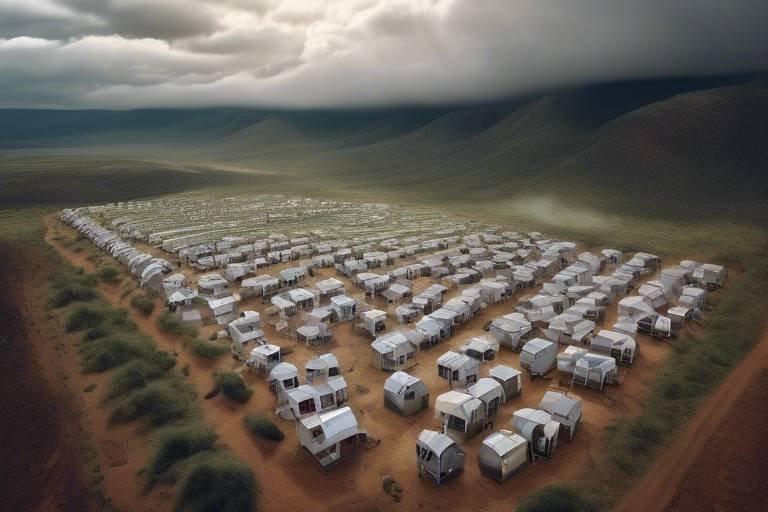Can Predictive Modelling Help Us Fight Climate Change?
Climate change is no longer just a distant threat; it’s a pressing reality that affects us all. As we grapple with rising temperatures, unpredictable weather patterns, and environmental degradation, the question arises: how can we effectively combat this global crisis? Enter predictive modelling—a powerful tool that harnesses data to forecast future climate scenarios and impacts. By simulating various environmental conditions and human activities, predictive modelling offers insights that can shape our response to climate change.
Imagine predictive modelling as a crystal ball for climate science. It allows researchers and policymakers to visualize potential futures based on current trends and actions. This capability is invaluable, especially when considering the complex interplay of factors that contribute to climate change, such as greenhouse gas emissions, deforestation, and urbanization. With predictive modelling, we can not only anticipate extreme weather events but also evaluate the effectiveness of our mitigation strategies. It’s like having a GPS for navigating the uncertain terrain of climate action.
Moreover, the benefits of predictive modelling extend beyond mere forecasting. It serves as a bridge between scientific research and practical solutions. By understanding potential outcomes, stakeholders can make informed decisions about resource allocation, infrastructure development, and emergency preparedness. In essence, predictive modelling empowers us to take proactive measures rather than reactive ones, which is crucial in the fight against climate change.
However, while the promise of predictive modelling is significant, it’s essential to recognize the challenges that accompany it. Data quality, availability, and the inherent uncertainties in climate projections can complicate our understanding. The accuracy of predictive models relies heavily on the data we feed them. In this sense, the old adage holds true: “garbage in, garbage out.” If the data is flawed or incomplete, the predictions can lead us astray.
As we look to the future, the potential of predictive modelling in climate action is immense. With advancements in technology and data analytics, we can refine our models to produce more accurate and actionable insights. This evolution will not only enhance our understanding of climate dynamics but also equip us with the tools necessary to combat climate change effectively. So, can predictive modelling help us fight climate change? The answer is a resounding yes, but it requires our commitment to improving data quality, embracing new technologies, and fostering collaboration across sectors.
- What is predictive modelling?
Predictive modelling is a statistical technique that uses historical data and algorithms to forecast future outcomes. In the context of climate science, it helps simulate various climate scenarios based on different variables. - How does predictive modelling help in climate change mitigation?
By providing insights into potential future scenarios, predictive modelling allows policymakers to assess the effectiveness of different strategies aimed at reducing greenhouse gas emissions. - What are the challenges associated with predictive modelling?
Challenges include data quality and availability, uncertainties in climate processes, and the need for continuous updates to reflect changing environmental conditions. - What advancements are being made in predictive modelling?
Advances in technology and data analytics are leading to more accurate models that can better inform climate action strategies and decision-making processes.

The Role of Predictive Modelling in Climate Science
Predictive modelling serves as a crucial element in the realm of climate science, acting like a crystal ball that allows researchers to peer into the future. Imagine being able to simulate various climate scenarios and assess potential impacts based on a myriad of factors and variables! This is precisely what predictive modelling accomplishes. It integrates complex datasets and sophisticated algorithms to forecast how our planet's climate might evolve over time. By doing so, it equips scientists with the tools they need to make informed decisions and create effective strategies to combat climate change.
At its core, predictive modelling uses historical data to identify trends and patterns. For instance, when scientists input data from past climate events, they can generate simulations that predict future occurrences. This process is akin to piecing together a jigsaw puzzle where each piece represents a different aspect of climate data, such as temperature, precipitation, and atmospheric composition. By analyzing these pieces, researchers can better understand how climate systems interact and what might happen under various scenarios.
Moreover, the ability to model different variables enables scientists to explore the potential impacts of human activities on climate change. For example, they can simulate the effects of increased greenhouse gas emissions or the implementation of renewable energy sources. This not only helps in understanding the direct consequences of our actions but also in crafting policies that can mitigate negative outcomes. In this way, predictive modelling acts as a guiding light for policymakers, providing them with the insights necessary to allocate resources strategically and prioritize initiatives that yield the greatest benefits.
Furthermore, predictive modelling plays a significant role in risk assessment. By evaluating the likelihood of extreme weather events, such as hurricanes or droughts, researchers can help communities prepare for potential disasters. This proactive approach is essential for minimizing the adverse effects of climate change on vulnerable populations and ecosystems. It’s like having a weather radar that alerts you to an approaching storm, allowing you to take shelter before the worst hits.
In summary, predictive modelling is not just a technical tool; it’s a vital component of climate science that enhances our understanding of complex climate dynamics. Its ability to simulate various scenarios and assess impacts makes it indispensable for researchers, policymakers, and communities alike. As we continue to grapple with the challenges posed by climate change, the importance of predictive modelling will only grow, paving the way for more informed and effective climate action.

Applications of Predictive Modelling
Predictive modelling is not just a buzzword; it’s a game-changer in the realm of climate science. Imagine having a crystal ball that can forecast not only the weather but also the long-term impacts of climate change. That’s precisely what these models do! They are utilized in various ways, from predicting extreme weather events to evaluating the effectiveness of climate mitigation strategies. The versatility of predictive modelling is astounding, and its applications are as diverse as the challenges we face in combating climate change.
One of the most prominent applications of predictive modelling is in weather forecasting and climate predictions. Advanced algorithms analyze vast amounts of data to enhance the accuracy of weather forecasts. For instance, when a severe storm is on the horizon, predictive models can provide timely alerts, allowing communities to prepare and adapt. This is crucial because, as we all know, preparation can mean the difference between chaos and safety. By understanding the potential intensity and path of a storm, local governments can take proactive measures to protect residents and infrastructure.
Moreover, predictive modelling aids in generating long-term climate projections. These projections are essential for policymakers who need to make informed decisions about resource allocation and strategic planning. Think of it like a roadmap; without it, navigating through the complexities of climate change would be nearly impossible. These models consider various factors such as greenhouse gas emissions, land use changes, and even socio-economic developments to simulate possible future scenarios.
In addition to long-term insights, short-term forecasting through predictive modelling provides immediate benefits. For example, during heatwaves or floods, having accurate short-term forecasts can help emergency responders act quickly, minimizing adverse effects on communities and ecosystems. It’s like having a lifeguard at the beach, ready to jump in at a moment’s notice. The quicker we respond to climate-related emergencies, the more lives we can save and the less damage we can inflict on our environment.
Another critical application of predictive modelling is assessing the effectiveness of various climate mitigation strategies. Stakeholders, from governments to NGOs, can use these models to identify the most promising approaches for reducing greenhouse gas emissions. For instance, if a city is considering implementing a new public transportation system, predictive modelling can help forecast its impact on emissions. This is vital because we need to ensure that our efforts are not just well-intentioned but also effective in making a tangible difference.
To illustrate this, consider the following table that summarizes some of the key applications of predictive modelling:
| Application | Description | Impact |
|---|---|---|
| Weather Forecasting | Enhances accuracy of weather predictions. | Improved preparedness for extreme weather events. |
| Long-term Projections | Guides policymakers in strategic planning. | Informed resource allocation to combat climate change. |
| Short-term Forecasting | Provides immediate insights for emergency response. | Minimized adverse effects on communities. |
| Mitigation Strategy Assessment | Evaluates effectiveness of climate strategies. | Identifies promising approaches for emission reduction. |
In conclusion, the applications of predictive modelling are vast and varied, serving as a crucial tool in our fight against climate change. By harnessing the power of these models, we can better prepare for the future, make informed decisions, and ultimately create a more sustainable world.
- What is predictive modelling? Predictive modelling uses statistical techniques to forecast future outcomes based on historical data.
- How does predictive modelling help in climate change? It helps simulate future climate scenarios, assess impacts, and evaluate mitigation strategies.
- What are the challenges of predictive modelling? Challenges include data limitations, uncertainties in climate processes, and the need for continuous updates.
- Can predictive modelling predict extreme weather? Yes, it enhances the accuracy of weather forecasts, allowing for better preparedness.

Weather Forecasting and Climate Predictions
When we think about the weather, it often feels like we’re playing a game of chance, doesn’t it? But thanks to predictive modelling, we’re not just rolling the dice anymore. Instead, we’re using data-driven insights to enhance our understanding of weather patterns and climate predictions. Imagine being able to foresee a storm before it hits, or knowing when to plant your crops for the best yield. That’s the power of predictive modelling in action!
Advanced predictive models utilize a range of data—from historical weather patterns to real-time atmospheric measurements—to create simulations that can forecast weather events with remarkable accuracy. These models help meteorologists and scientists analyze an array of factors such as temperature, humidity, wind speed, and precipitation. By synthesizing this information, they can generate forecasts that not only tell us what the weather will be like tomorrow but also project climate trends over the next few decades.
One of the most significant benefits of these models is their ability to enhance our preparedness for extreme weather events. For instance, think about hurricane season. With accurate predictive modelling, communities can receive timely warnings about potential hurricanes, allowing them to evacuate or prepare accordingly. This proactive approach can save lives and minimize property damage. Additionally, seasonal forecasts can help farmers plan their planting schedules, ensuring they make the most of favorable weather conditions.
However, it’s not just about short-term forecasts. Predictive modelling also plays a crucial role in long-term climate projections. By analyzing data over extended periods, scientists can identify trends and patterns that may not be obvious in short-term observations. This long-term insight is invaluable for policymakers who need to make informed decisions about resource allocation and climate resilience strategies. It’s like having a crystal ball that helps us navigate the uncertain waters of climate change.
In summary, powered by predictive modelling are transforming our approach to understanding and responding to environmental changes. These models not only improve our immediate responses to weather events but also equip us with the knowledge to plan for a sustainable future. As technology continues to advance, we can expect even more refined models that will enhance our ability to adapt to the ever-changing climate landscape.
- What is predictive modelling?
Predictive modelling is a statistical technique that uses historical data to forecast future outcomes. In climate science, it helps simulate potential climate scenarios based on various environmental factors.
- How accurate are weather forecasts?
Weather forecasts have become increasingly accurate due to advancements in predictive modelling. However, accuracy can vary based on the timeframe and the complexity of the weather system being predicted.
- Can predictive modelling help in disaster preparedness?
Yes, predictive modelling is instrumental in disaster preparedness by providing timely forecasts that allow communities to take necessary precautions against extreme weather events.

Long-term Climate Projections
Long-term climate projections are like a crystal ball for our planet's future, allowing scientists and policymakers to peer into what lies ahead. These projections utilize sophisticated predictive modelling techniques to simulate various climate scenarios based on different variables, such as greenhouse gas emissions, land use changes, and technological advancements. Imagine being able to forecast not just the weather for tomorrow, but the climate for decades to come! This capability is invaluable as it helps us understand the potential impacts of our current actions on the environment.
One of the most significant benefits of long-term projections is their ability to inform strategic planning. By understanding potential future scenarios, policymakers can develop targeted strategies to mitigate adverse effects. For instance, if a model predicts increased flooding in a particular region due to rising sea levels, local governments can prioritize investments in infrastructure improvements and community resilience programs. The foresight provided by these models can ultimately save lives and resources.
Moreover, long-term climate projections can guide resource allocation, ensuring that funds are directed toward the most pressing challenges. For example, if projections indicate that certain agricultural regions will become less viable due to changing rainfall patterns, investments can be redirected to support farmers in adapting to new conditions. This proactive approach not only helps safeguard food security but also strengthens local economies.
However, it's essential to recognize that these projections are not set in stone. They are based on a variety of assumptions and scenarios, which means that the outcomes can vary significantly depending on our choices today. This uncertainty highlights the importance of continuous monitoring and updating of models to reflect real-time data and changes in climate dynamics. As we gather more data and refine our models, we can improve the accuracy of these projections, making them even more reliable for decision-making.
To illustrate the potential impacts of long-term climate projections, consider the following table that summarizes projected temperature increases based on different greenhouse gas emission scenarios:
| Emission Scenario | Projected Temperature Increase (°C) | Potential Impacts |
|---|---|---|
| Low Emissions | 1.5 | Minimal impacts on ecosystems and human health |
| Moderate Emissions | 2.5 | Increased heatwaves and flooding events |
| High Emissions | 4.0 | Severe impacts on agriculture, water supply, and biodiversity |
In conclusion, long-term climate projections are indispensable tools in our fight against climate change. They empower us with the knowledge needed to make informed decisions today that will shape a sustainable future. As we continue to refine our predictive models and gather more data, the insights we gain will be crucial in guiding our actions to protect our planet for generations to come.
- What is predictive modelling? Predictive modelling is a statistical technique used to forecast future outcomes based on historical data and various influencing factors.
- How accurate are long-term climate projections? While they provide valuable insights, the accuracy of long-term projections can vary depending on the assumptions and data used.
- What can policymakers do with climate projections? Policymakers can use climate projections to develop strategies for mitigation and adaptation, ensuring that communities are prepared for future climate impacts.
- Why is continuous updating of models important? Continuous updating ensures that models reflect the latest data and changes in climate dynamics, improving their reliability for decision-making.

Short-term Forecasting Benefits
Short-term forecasting through predictive modelling serves as a vital lifeline for communities grappling with the unpredictable nature of climate change. Imagine waking up to a storm warning that allows you to prepare adequately, ensuring your family and property are safe. This is the power of accurate short-term predictions. By harnessing advanced algorithms and real-time data, predictive models can provide insights that enable immediate responses to climate-related emergencies.
One of the most significant benefits of short-term forecasting is its ability to enhance community preparedness. When local authorities receive timely predictions about extreme weather events such as hurricanes, floods, or heatwaves, they can mobilize resources more effectively. This proactive approach not only saves lives but also minimizes economic losses. For instance, evacuating residents ahead of a hurricane can significantly reduce the risk of casualties and property damage.
Moreover, short-term forecasting helps in optimizing resource allocation. Emergency services, such as fire departments and medical teams, can position themselves in strategic locations based on predictive insights. This ensures they are ready to respond swiftly, reducing the response time during critical situations. Additionally, agricultural sectors benefit from short-term weather forecasts by adjusting planting schedules and irrigation practices, thus increasing crop yields and food security.
To illustrate the impact of short-term forecasting, consider the following table that summarizes key benefits:
| Benefit | Description |
|---|---|
| Enhanced Preparedness | Allows communities to take preventive measures against extreme weather events. |
| Resource Optimization | Enables efficient allocation of emergency services and resources. |
| Agricultural Adjustments | Helps farmers adapt their practices based on weather predictions. |
In addition to these benefits, short-term forecasting plays a crucial role in public awareness and education. When communities are informed about impending weather conditions, they are more likely to take appropriate action. This fosters a culture of preparedness, where individuals and families understand the importance of staying informed and ready for climate-related challenges.
In conclusion, short-term forecasting through predictive modelling is not just a technological advancement; it is a crucial tool that empowers communities to face the uncertainties of climate change head-on. With the right information at their fingertips, people can make informed decisions that protect their lives and livelihoods, ultimately fostering resilience in the face of an ever-changing climate.
- What is predictive modelling? Predictive modelling is a statistical technique that uses historical data and algorithms to forecast future outcomes, particularly in climate science.
- How does short-term forecasting help in emergencies? It provides timely alerts about extreme weather events, allowing communities to prepare and respond effectively, thereby minimizing risks and damages.
- Can short-term forecasts be inaccurate? While predictive modelling has advanced significantly, uncertainties still exist due to variations in data and climate processes, but ongoing improvements aim to enhance accuracy.
- What technologies are used in predictive modelling? Technologies such as machine learning, artificial intelligence, and big data analytics are commonly employed to improve the accuracy and reliability of predictions.

Assessing Mitigation Strategies
Predictive modelling plays a pivotal role in aimed at combating climate change. By simulating various scenarios, researchers can evaluate the effectiveness of different approaches to reduce greenhouse gas emissions. This process is akin to a chess game, where each move can significantly impact the outcome of the match. In this context, understanding the implications of each strategy allows stakeholders to make informed decisions.
One of the most significant benefits of predictive modelling in this area is its ability to analyze the potential outcomes of various mitigation strategies before they are implemented. For instance, when considering renewable energy initiatives, predictive models can forecast the expected reduction in carbon emissions based on the scale of implementation. This approach not only helps in identifying the most effective strategies but also allows for the allocation of resources where they will have the greatest impact.
Moreover, predictive modelling can assist in assessing the cost-effectiveness of different strategies. By evaluating the economic implications alongside environmental benefits, decision-makers can prioritize initiatives that offer the best return on investment. For example, a model might reveal that investing in energy efficiency upgrades in buildings could yield higher emissions reductions per dollar spent compared to other strategies, such as afforestation.
However, assessing the effectiveness of mitigation strategies is not without its challenges. The complexities of climate systems mean that outcomes can be influenced by a multitude of factors, including technological advancements, policy changes, and even social behaviors. As a result, predictive models must be continually updated to reflect the latest data and trends. This dynamic nature of climate science necessitates ongoing collaboration among scientists, policymakers, and industry stakeholders.
In summary, predictive modelling serves as a powerful tool in evaluating mitigation strategies, enabling stakeholders to identify the most promising approaches for reducing greenhouse gas emissions. By providing insights into potential outcomes, costs, and effectiveness, it empowers decision-makers to take impactful actions against climate change. As we continue to refine these models, the path toward a sustainable future becomes clearer, allowing us to tackle the climate crisis with greater confidence.
- What is predictive modelling?
Predictive modelling is a statistical technique that uses historical data to forecast future events. In climate science, it helps simulate various scenarios to understand potential climate impacts.
- How does predictive modelling help in climate action?
It assists in assessing the effectiveness of mitigation strategies, forecasting extreme weather events, and guiding policymakers in resource allocation to combat climate change.
- What are the challenges of predictive modelling?
Challenges include data limitations, uncertainties in climate processes, and the need for continuous updates to reflect changing conditions.
- Can predictive modelling predict extreme weather events?
Yes, advanced predictive models enhance the accuracy of weather forecasting, allowing communities to better prepare for extreme weather events.

Challenges in Predictive Modelling
While the potential of predictive modelling in combating climate change is significant, it is not without its challenges. One of the primary hurdles is the quality and availability of data. Predictive models rely heavily on accurate, high-resolution datasets that reflect current environmental conditions. Unfortunately, many regions, especially developing countries, lack the necessary data infrastructure. This can lead to gaps in information that compromise the reliability of the models. Think of it like trying to build a house without a solid foundation; if the data isn’t robust, the predictions can crumble under scrutiny.
Another challenge lies in the uncertainty of climate projections. Climate systems are incredibly complex, and small variations in input data can result in drastically different outcomes. This uncertainty can be likened to trying to predict the stock market; even the slightest change can lead to unexpected results. Thus, it is crucial for researchers to develop robust methods that can quantify and manage these uncertainties. By doing so, they can provide more reliable forecasts that policymakers can trust when making decisions.
Moreover, the dynamic nature of climate change poses an ongoing challenge. The climate is not static; it evolves due to various factors, including human activities and natural phenomena. As such, predictive models must be continuously updated to reflect these changes. This need for ongoing refinement can strain resources and complicate the modelling process. Imagine trying to catch a moving target with a dart; if your aim is based on outdated information, you’re likely to miss the mark.
Lastly, there is the issue of interdisciplinary collaboration. Climate change is a multifaceted problem that requires input from various fields, including meteorology, environmental science, economics, and social sciences. Effective predictive modelling necessitates collaboration among experts from these disciplines to ensure that all relevant factors are considered. Without this teamwork, models may overlook critical variables, leading to less effective strategies in combating climate change.
In summary, while predictive modelling holds great promise in the fight against climate change, it is essential to address these challenges head-on. By improving data quality, managing uncertainty, adapting to changes, and fostering collaboration, we can enhance the effectiveness of predictive models and, ultimately, our efforts to protect our planet.
- What is predictive modelling in the context of climate change?
Predictive modelling involves using statistical techniques and algorithms to forecast future climate scenarios based on current and historical data.
- How does data quality affect predictive modelling?
The accuracy of predictive models relies on high-quality data; poor data can lead to unreliable forecasts.
- What are the main uncertainties in climate projections?
Uncertainties can arise from variations in input data, the complexity of climate systems, and the dynamic nature of climate change itself.
- Why is interdisciplinary collaboration important in predictive modelling?
Collaboration among experts from various fields ensures that all relevant factors are considered, leading to more accurate and effective models.

Data Quality and Availability
When it comes to predictive modelling in climate science, the quality and availability of data are absolutely paramount. Imagine trying to build a house without a solid foundation; that’s what it’s like trying to create accurate climate models without reliable data. High-quality data ensures that models can reflect real-world conditions and predict future scenarios with a reasonable degree of accuracy. However, the challenge lies in obtaining comprehensive datasets that are both rich in detail and wide-ranging in scope.
One major hurdle is that climate data often comes from a variety of sources, including satellite observations, ground-based measurements, and climate simulations. Each of these sources has its own strengths and weaknesses, which can complicate the integration process. For instance, satellite data might provide extensive coverage but can lack the granularity that ground measurements offer. Therefore, researchers must work diligently to harmonize these datasets, ensuring that they complement rather than contradict each other.
Moreover, the temporal and spatial resolution of data plays a crucial role in its usability. High-resolution data can provide insights into localized climate phenomena, while broader datasets can help in understanding global trends. For example, consider the following table that outlines the differences in data types and their implications for predictive modelling:
| Data Type | Resolution | Usefulness |
|---|---|---|
| Satellite Data | Global | Good for large-scale patterns |
| Ground Measurements | Local | Essential for detailed analysis |
| Climate Simulations | Variable | Useful for hypothetical scenarios |
In addition to resolution, the timeliness of data is also crucial. Climate conditions can change rapidly, and outdated data can lead to erroneous predictions. Therefore, continuous monitoring and updating of datasets are essential to keep models relevant. This need for real-time data often leads to collaborations between governments, academic institutions, and private organizations to pool resources and share information.
Ultimately, the quest for high-quality and readily available data is a journey filled with challenges. However, overcoming these obstacles is vital for the future of predictive modelling in climate science. By ensuring that data is both reliable and accessible, researchers can create models that not only predict future climate scenarios but also inform effective strategies for mitigation and adaptation. In the end, when we talk about fighting climate change, it’s not just about having the right tools; it’s about having the right information to guide those tools.
- What is predictive modelling?
Predictive modelling is a statistical technique that uses historical data to predict future outcomes. In climate science, it helps simulate various climate scenarios. - Why is data quality important in climate science?
High-quality data is essential for accurate predictions. Poor data can lead to misleading results, which may hinder effective climate action. - How can data availability improve climate predictions?
Increased data availability allows for more comprehensive models that can account for various factors affecting climate, leading to better forecasts and informed decision-making.

Uncertainty in Climate Projections
When we talk about climate projections, one word often looms large: uncertainty. This uncertainty is not just a minor detail; it’s a fundamental challenge that can shape our understanding of climate change and its impacts on our planet. Imagine trying to predict the path of a storm while knowing that even the slightest change in wind direction could lead to vastly different outcomes. This analogy perfectly captures the essence of climate modeling. Just as a small gust can alter a storm's trajectory, tiny variations in our input data can lead to significant discrepancies in climate projections.
One of the primary reasons for this uncertainty lies in the complex nature of climate systems. Climate is influenced by a multitude of factors, including atmospheric conditions, ocean currents, and even human activities. Each of these elements interacts in intricate ways, and predicting their behavior over time is no easy feat. For instance, even slight changes in greenhouse gas emissions can lead to different warming scenarios. This complexity necessitates the use of sophisticated models, which, while powerful, are not infallible.
Moreover, the data we rely on to feed these models can vary in quality and completeness. High-resolution datasets are essential for accurate predictions, yet they are often limited or difficult to obtain. This can lead to gaps in our understanding and, consequently, in the models themselves. As researchers strive to improve the accuracy of climate projections, they must also contend with the inherent uncertainties that come from the data they use. This interplay between data quality and model reliability is a critical area of focus in climate science.
To illustrate the impact of uncertainty in climate projections, consider the following key points:
- Input Variability: Different assumptions about future emissions and socio-economic factors can lead to vastly different climate outcomes.
- Model Limitations: No model can account for every variable, and simplifications are often necessary, which can introduce errors.
- Feedback Mechanisms: Climate systems are dynamic, and feedback loops (like ice melt leading to more heat absorption) can complicate predictions.
Addressing uncertainty is crucial for effective climate action. Policymakers and stakeholders need to understand the range of possible futures, which means not only relying on a single model or projection but considering a spectrum of scenarios. This approach can help in formulating strategies that are robust under various potential climate outcomes. As we move forward, improving our understanding of these uncertainties through enhanced data collection and model refinement will be essential in our fight against climate change.
- What causes uncertainty in climate projections? Uncertainty arises from various factors, including data quality, model limitations, and the complexity of climate systems.
- How can we manage uncertainty in climate models? By using multiple models and scenarios, policymakers can better prepare for a range of possible climate futures.
- Why is understanding uncertainty important? It helps stakeholders make informed decisions and develop strategies that are resilient to different climate outcomes.

The Future of Predictive Modelling in Climate Action
The future of predictive modelling in climate action is not just bright; it’s practically glowing with possibilities! As we stand on the brink of a climate crisis, the integration of advanced technologies and data analytics is becoming increasingly crucial. Imagine a world where we can not only predict future climate scenarios but also tailor our responses in real-time. This is the promise of predictive modelling—a tool that can revolutionize how we approach climate change.
With advancements in machine learning and artificial intelligence, predictive models are becoming more sophisticated. They can analyze vast amounts of data from various sources, including satellite imagery, weather patterns, and even social media trends, to provide a comprehensive view of our changing environment. This means we can anticipate climate-related events before they happen, allowing for proactive measures rather than reactive ones. For instance, we might predict a drought weeks in advance, enabling farmers to adjust their planting schedules or conserve water resources.
Moreover, the potential for predictive modelling extends beyond just forecasting weather patterns. It can also play a pivotal role in informing policy decisions. By simulating the impacts of different climate policies, predictive models can help policymakers understand the long-term effects of their choices. This is especially important as we navigate complex issues like carbon pricing, renewable energy adoption, and deforestation. The insights gained from these models can guide us towards more sustainable practices and help allocate resources more effectively.
But let’s not forget about the importance of collaboration in this journey. The future of predictive modelling in climate action relies heavily on partnerships between scientists, governments, and the private sector. By sharing data and resources, we can create more robust models that reflect the complexities of our planet. For example, a collaborative approach could lead to the development of a global climate model that incorporates regional variations and local knowledge, providing a more accurate picture of climate impacts worldwide.
As we look ahead, it’s essential to address the challenges that come with predictive modelling. Issues such as data quality, availability, and uncertainty must be tackled head-on. However, with the right investments in technology and infrastructure, we can overcome these hurdles. The future is not just about what we can predict; it’s about how we can act on those predictions to create a more resilient world.
In conclusion, the future of predictive modelling in climate action is a tapestry woven with innovation, collaboration, and proactive strategies. As we harness the power of technology to understand and combat climate change, we must remain committed to using these tools responsibly. Together, we can turn predictions into actions that safeguard our planet for generations to come.
- What is predictive modelling?
Predictive modelling is a statistical technique that uses historical data to forecast future outcomes. In the context of climate change, it helps scientists simulate various climate scenarios and their potential impacts.
- How can predictive modelling help in climate action?
It allows for better planning and response strategies by providing insights into future climate conditions, helping policymakers make informed decisions about resource allocation and mitigation strategies.
- What are the main challenges of predictive modelling?
Challenges include data quality and availability, uncertainty in climate projections, and the need for continuous updates to reflect changing environmental conditions.
- How can technology improve predictive modelling?
Advancements in machine learning and AI enable more sophisticated analyses of large datasets, leading to more accurate and actionable predictions.
Frequently Asked Questions
- What is predictive modelling in the context of climate change?
Predictive modelling in climate change refers to the use of advanced mathematical and statistical techniques to simulate future climate scenarios. It helps researchers understand potential impacts based on various environmental factors, allowing for informed decision-making in climate action.
- How can predictive modelling help in weather forecasting?
Predictive modelling enhances weather forecasting by using complex algorithms to analyze vast amounts of data. This leads to improved accuracy in predicting extreme weather events, enabling communities to prepare better and adapt to changing climate patterns.
- What are the benefits of long-term climate projections?
Long-term climate projections provide critical insights for policymakers by outlining potential future scenarios. This information is essential for strategic planning, resource allocation, and developing effective climate mitigation strategies.
- What challenges does predictive modelling face?
Predictive modelling faces several challenges, including data limitations, uncertainties in climate processes, and the necessity for continuous updates. These challenges can affect the accuracy and reliability of climate projections, making it crucial to address them effectively.
- How does data quality impact predictive modelling?
The quality and availability of data are vital for the accuracy of predictive models. High-resolution and comprehensive datasets are necessary to ensure that the models can accurately reflect climate conditions and provide reliable forecasts.
- What is the significance of uncertainty in climate projections?
Uncertainty in climate projections is significant because small variations in input data can lead to vastly different outcomes. Understanding and managing this uncertainty is crucial for developing robust predictive models that can inform effective climate action.
- What does the future hold for predictive modelling in climate action?
The future of predictive modelling in climate action looks promising, with advancements in technology and data analytics. These developments will enable more accurate and actionable insights, helping to tackle climate change challenges more effectively.



















